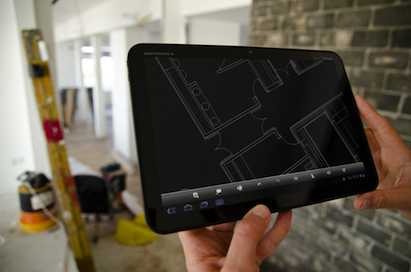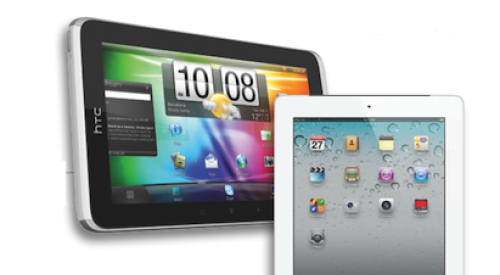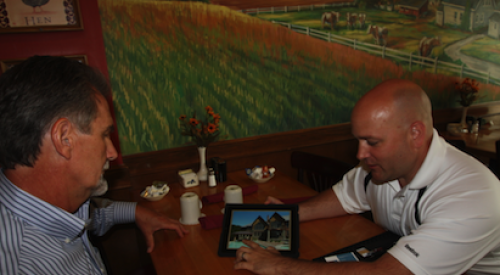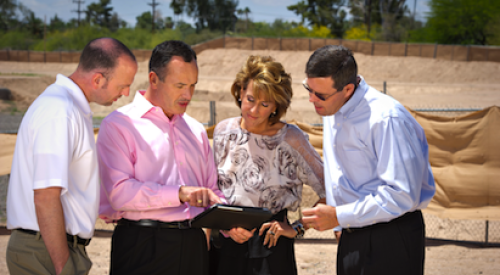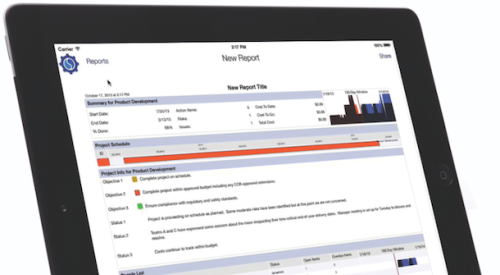Building in the summer in Georgia is never pleasant, but this summer the sweltering heat pushed past the point of discomfort into the danger zone. Daily heat advisories warned against being outside anymore than absolutely necessary. John Leibach, VP and controller of Augusta, Ga.-based Keystone Homes, remembers days like those from when he was working in the field.
“I had a big box in the truck with files,” Leibach recalls. “When it’s 100 degrees, you won’t dig through that to find something.”
Keystone Homes senior builder Myron Fowler doesn’t have to worry about that. Instead of a box in his truck, he has complete files on every house he’s building in the two neighborhoods he oversees on an iPad. Each file has purchase orders, floor plans, site plans, selections, colors, and neighborhood plats. He has the entire schedule and the names and contact information of every trade partner working on every house. And all files are accessible at a moment’s notice using the free web-based file-hosting service Dropbox.
At the framing stage of a house, Fowler can check the position, size, and swing of all the doors, as well as the location and size of all the windows on the plans against the work that was done. Using the Builder MT trade portal app for the iPad, Fowler can verify the purchase orders and compare them to what was actually delivered. If there are discrepancies, he can take a photo, write a note on it with Adobe Ideas, and email it with a copy of the plan to the trade partner. He can also write instructions on the plans with PDF Notes.
6 ways builders are using tablets to manage construction operations
1. Instant access to construction documents — Using file-hosting apps like Dropbox, builders can access virtually any construction documents from the field, including purchase orders, floor plans, site plans, selections, colors, and neighborhood plats.
2. Jobsite inspections — For instance, superintendents can snap a photo of a problem area, write a note on it, and email it along with a copy of the plans.
3. Face-to-face meetings remotely — Builders, supers, trade partners, and suppliers can have instant video-conference meetings using apps like Apple’s FaceTime and Skype.
4. Installation videos and instructions — Instant access to streaming video and a large, crystal-clear screen allow builders to easily troubleshoot a product installation or double-check proper installation techniques while on the jobsite.
5. Storm tracking — Apps from WeatherBug and the Weather Channel provide advanced weather data that allow builders to make better-informed decisions on construction projects.
6. Remote access to enterprise data — For builders that use enterprise management systems like Sage, Builder MT, and Kova Solutions, tablets can tie directly into workflow, schedule, accounting, estimating, purchasing, and project management systems, providing a host of benefits.
“I was used to toting paper,” Fowler says. “Now I have everything at the touch of a finger. If someone calls me from a house down the street, I can call up the plans right here and answer their questions without running down there. The potential is huge.”
The potential is indeed huge. Tom Gebes, president of Builder MT, says that with their portability, speed, and versatility, tablets are “showing builders they can finally take process improvement out on the job site.
“For $500, they can arm their superintendents with an iPad and give them access to this stuff 24/7,” Gebes says. “That’s huge. It’s not a $2,000-$3,000 [computer]. It’s affordable, it’s extremely efficient, and it impacts every aspect of their business.”
Consider this: A superintendent walking the job site with an iPad at framing stage can check off that the first floor frame is complete. With that, an authorization goes through to pay the framer. A message gets sent to the sales department that construction has started, so don’t sell any more options.
“It eliminates the need for the sales office to be concerned they’ll sell something the builder can’t build and communicates with accounting about cash flow,” Gebes says. “If I have a lot of rain and the job is delayed a month, I can see how that will affect me as a builder. That’s all from one entry from that iPad.”
In the field, builders also can access a wealth of manufacturer information on the iPad, including product photos, specifications, material safety data sheets, warranties, and installation videos.
Tablets quickly becoming the dominant choice
Since the iPad first hit the market in April 2010, Gebes says about 25 percent of the trade partners using Builder MT’s trade portal have started using them. “I think we’ll see an adoption rate over the next year that will be staggering.”
The advantage tablets have over a Blackberry or other smart phones is significant: they have a near-full-sized keyboard and what people refer to as “screen real estate” — a big enough monitor to actually be able to see plans and photos clearly and make notes on them. The advantage over laptops and netbooks is the touch screen that makes them simple to use. Plus, there’s no lag time waiting for the device to boot up.
Tablet Report Contents
Exclusive Research
Tablets on the Jobsite
Designing with Tablets
Using Tablets to Market and Sell Homes
Product Review: Which Tablet is Right for You?
99 Tablet Apps Made for Builders
As many iPhone owners have discovered with cracked screens, the down side of a thin, lightweight device is fragility, especially on a construction site. Keystone Homes purchased hard shell OtterBox cases for its six iPad 2 tablets. “We wouldn’t let them out of the office without the cases,” Leibach says.
Fowler, who doesn’t consider himself a particularly tech-savvy individual, says the iPad is simple to use. Email is much easier on the iPad than on the Blackberry he used to carry.
That’s a godsend to Cindy Christian, controller and IT manager for Vintage Homes in Cordova, Tenn. One of her builders threatened to quit in frustration over the company’s use of Blackberrys for wireless scheduling — the screen was too small for him to see it clearly and the keyboard was too small for his finger.
“It was too hard,” Christian says. “He’s so excited about the iPad. He can blow up the screen so he can see what he needs to. You can see what you’re clicking on. You have a stylus, you can take pictures in the field, you can read your email. It’s worked out really well.”
The capabilities of the iPad have helped both Keystone Homes and Vintage Homes keep their builders in the field instead of driving back to the office from far-flung job sites for meetings.
“There’s no telling how much money this will save us,” Christian says. “We have some job sites in Mississippi that are an hour down and an hour back. That saves our builders at least two hours of getting nothing done. It’s pretty amazing.”
Tablets have nearly unlimited uses
Builders who are using tablets in the field say they feel like they’ve barely scratched the surface of what the technology can do.
“It’s absolutely transformational,” says Tom French, president of Alamogordo, N.M.-based French Brothers Inc., which is on schedule to close 70 homes in 2011. His company discovered iPads when it made the investment in an enterprise system it bought from Mark Systems. French says he was going to outfit his superintendents with netbooks for wireless scheduling and payments, but a college intern helping with the data migration suggested looking at iPads.
“It was the right decision,” French says. The superintendents love it. It’s easy to use. You turn it on and it’s working. You don’t have to wait for it to boot up. There’s no keypad to get dirty. Our superintendents carry iPads everywhere they go.”
The CAD department at Vintage Homes uses Google Earth constantly “to get a better handle on costs to prepare the site,” Christian says.
Lamar Crowell, president of Keystone Homes, uses his iPad to access MLS data when he walks houses so he can run comps of competing houses for sale. He takes pictures constantly of his houses; the GPS coordinates on iPhoto keep track of where they were all taken. And like many builders, Crowell loves the Weather Channel app.
“It’s got these nice big pictures with moving maps,” he says. “If you’re sitting there with the concrete guy trying to decide if you can pour concrete, this is much more accurate than a weather forecast.”
iPad is more than a piece of equipment
Many builders say their decision to use tablets has been driven at least in part by the fact that their customers are using the cutting-edge technology and they want to keep pace. French Brothers had this demonstrated to them in perhaps the worst possible way: A customer brought his iPad along on a visit to his under-construction home, Googled the manufacturer installation instructions of an item in the house, and told the superintendent it had not been installed correctly.
“In our defense, we were installing it the way all the trades did, but they weren’t doing it according to the way the manufacturer wanted it done,” French says. “It taught us a valuable lesson. If customers can do it, we can do it. Now we download PDFs of installation instructions. We have a little library so superintendents can pull them up in the field. We were talking about a hot-water heater in a meeting and one of our newer superintendents had a video about it playing before we finished the conversation.”
French is quick to point out that the impact is from more than just a piece of equipment. “It’s the commitment to use technology in a disciplined way,” he says. “People are seeing the power in that level of discipline. Our quality keeps going up and our costs keep going down. Everything is moving in the direction it’s supposed to move. We had our most profitable year ever.”
It’s not surprising then that French Brothers is looking ahead and planning for growth.
“We feel like we’ve gotten good enough with the system that we’re going to expand to other geographic areas,” French says. “Since our system is Internet-based, we don’t have to expand overhead to do that. That’s when we really start to see economies of scale.”
Keystone Homes’ Fowler is thinking about the possibilities, too. He can meet with another Keystone builder who works about 50 miles away without wasting two hours of driving time. He can actually take a vacation and keep an eye on his jobsites.
“Everything I need is on here,” he says.
